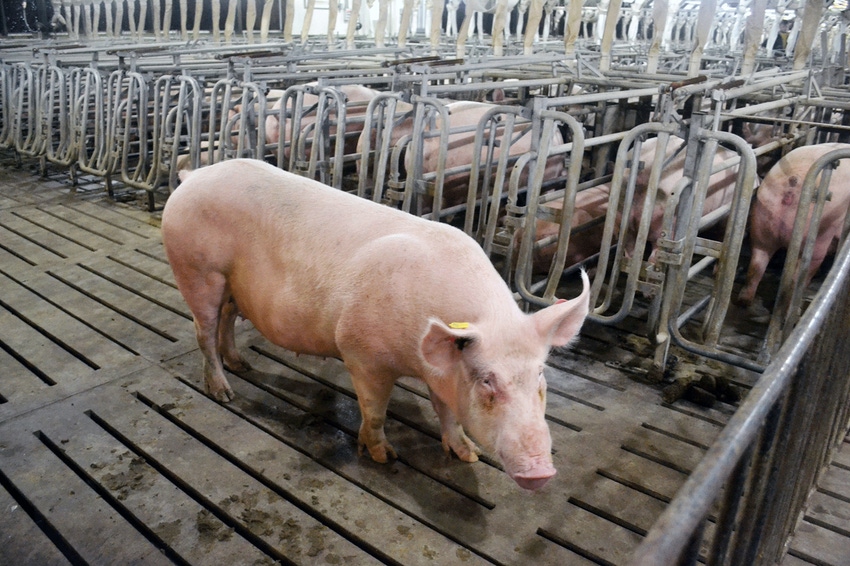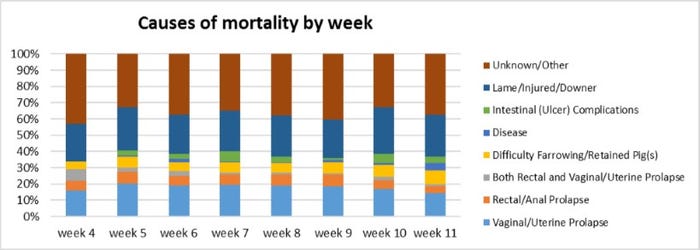Pork industry works together to tackle leading causes of sow mortality.
April 3, 2018

By Chris Rademacher, Iowa State University Clinical Associate Professor and Swine Extension Veterinarian; Amanda Chipman, Iowa State University Extension Program Specialist; and Jason Ross, Iowa State University Associate Professor and Iowa Pork Industry Center Director
Sow mortality, specifically as the result of pelvic organ prolapses, has significantly increased in recent years in the U.S. swine industry. Pelvic organ prolapses would be defined as either a rectal, vaginal, uterine or some combination of these different prolapse types. This epidemic sow welfare and production issue, while widely acknowledged among producers, academia and allied swine industry partners, has persisted and continued to worsen. This recent increase in prolapses has been reported across different regions and producers frustrating producers and veterinarians alike, mostly due to lack of mitigation strategies, or even the ability to execute mitigation-based research projects. The inability to pursue hypothesis-driven research projects is the result of lacking a fundamental understanding of the root cause(s) contributing to the increased prolapses in the swine industry.
In response to this significant industry need, the National Pork Board awarded funding to the Iowa Pork Industry Center at Iowa State University to lead the industry-wide effort on the identification of specific areas that may be contributing to prolapse incidence. To do this, the IPIC, with the assistance of faculty and industry leaders has developed a unique industry-wide collaboration between academia, integrated producers, and independent producers to collect and analyze a breadth of information to facilitate a better understanding of factors that potentially contribute to pelvic organ prolapse. At this point, the project includes the involvement of 109 sow farms (more than 400,000 sows) across 16 states in the United States. These sow farms are of varying sizes, ownership, facility types and genetics.
The long-term objective of the project is to identify causation for the elevated industry incidence of pelvic organ prolapse so that mitigation strategies can be developed and employed. As such, results of the project are intended to create focused hypotheses for further research seeking to test putative causes and mitigation strategies for producers to implement on their farms. As such, the project is collecting information on genetics, nutrition, management protocols, facilities, environment, health history, and status as well as individual animal measurements during late-gestation. This large network of sow farm managers and industry partnerships gives the project a unique dimension that is required to collect accurate data producing information that can be applied directly back to the commercial industry.
The IPIC is working with large production systems and smaller independent producers, various sow housing designs, and numerous different genetics striving to represent the industry as a whole. We have enrolled farms that have high, medium and low reported levels of prolapses to identify and analyze the possible risk factors that appear to be more commonly associated with pelvic organ prolapse. A component of this project is to gather consistent mortality data across all farms to create accurate benchmarking that we distribute back to the participating groups in a confidential manner. This is accomplished by all sow mortalities being submitted weekly using consistent definitions that enable tracking by causes of mortality (Figure 1), individual farm trends and industry-wide trends.
Figure 1: Distribution of reason for sow mortality

Figure 1 shows the distribution of causes of mortality for the first eight weeks of the study by calendar week for 2018. On average, pelvic organ prolapses represent 27% of all mortality, lameness and injury represent 25%, and unknown causes represent almost 38% of all mortality. Of the sow mortality caused by pelvic organ prolapses, those with uterine prolapses on average represent almost 21% of the total 27%.
While the project remains in its relatively early stages, it has been largely successful in creating a national industry partnership and underscores pork producer’s collaborative nature and their commitment to continuous improvement of animal health and well-being. Furthermore, the networks that the IPIC has established with industry and academic partners are expected to facilitate rapid dissemination of project results as they become available.
You May Also Like



